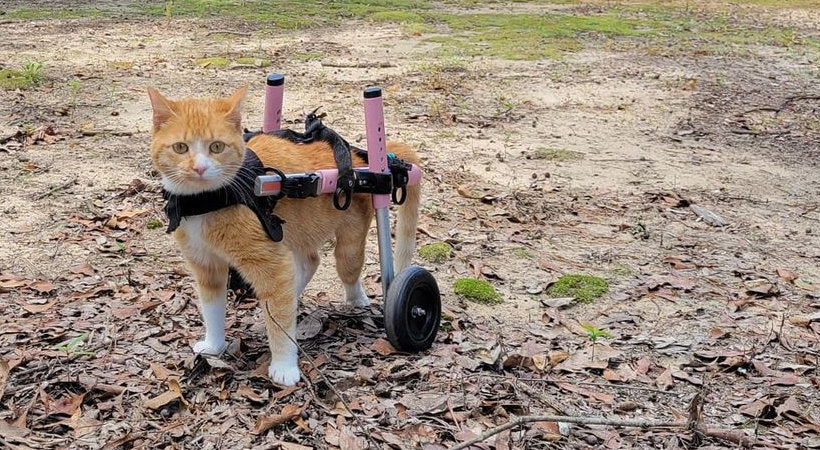Beagle Lifespan: How Long Do Beagles Live? (Life Expectancy)

Arthritis in Cats
It’s easy to assume that your senior cat is slowing down due to old age, but the truth is that they may actually be experiencing mobility loss caused by arthritis. Arthritis in cats is a common condition in older and senior felines. Older cats with arthritis will experience joint pain and stiffness that can make moving difficult and even painful.
What is Feline Arthritis?

In a young, healthy cat they can move easily, the bones are protected by cartilage and joint fluid that makes it easy for your cat to walk. A cat dealing with arthritis has experienced a breakdown of that cushioning between their bones. This causes the bones to grind against each other as they move, slowly wearing away at the joint and making it harder to walk naturally.
Cats are extremely skilled at masking signs of pain and due to their natural agility arthritis often goes undiagnosed in felines. A cat can experience arthritis in any joint in their body. The most common joints for feline arthritis include:
- Hip
- Elbow
- Shoulder
- Knee or stifle
- Ankle or tarsal
- Backbone or spine
Cats diagnosed with osteoarthritis commonly experience joint pain in their hip and elbow joints.


Signs of Arthritis in Cats

Diagnosing a cat with arthritis is much more challenging than in dogs. A decrease in a dog’s range of motion along with a reluctance to be touched are often the first signs of arthritis pain in dogs. Whereas cats can naturally resist attention and refuse to be touched for no reason. The most noticeable sign a feline has arthritis is often a noticeable drop in activity level. Other signs of feline arthritis include:
- A change in the way they walk and may cause the cat to limp
- Joint stiffness, especially after long periods of inactivity (like after a nap)
- Reluctance to use the stairs or an increased caution when on the stairs
- Change in personality, such as increased irritability and aggression
- Hiding or sleeping more often
- Not jumping as high as they could before
- Struggling to use the litter box
Licensed Vet Tech, Amber LaRock says, "Feline arthritis often causes joint stiffness and pain, so the symptoms of this condition will often reflect that. The most common signs of feline arthritis include stiff movements when walking, difficulty getting up and down, hesitance to jump on furniture or into cat trees, decreased flexibility, and even swollen joints."
Can Cats Get Arthritis in Their Back Legs?
A cat's back legs can be impacted by arthritis. Degenerative joint disease and arthritis often leads to debilitating mobility loss in cats. The knee and hip are two of the most common joints affected by feline arthritis. In severe cases, a cat may be unable to bear weight or walk on their back legs. The pain can be bad enough that a cat begins to drag their back legs behind them to get around. A cat wheelchair can be beneficial to promote mobility and continued exercise in cats with osteoarthritis in their back legs.
What Causes Feline Arthritis?
Most common in old age, arthritis typically develops due to wear and tear on a cat's joints. Cats who have suffered a past injury, especially a broken bone, are more likely to develop arthritis when they're older. Additional high-risk cats are cats with hip dysplasia and weight problems.
Arthritis Treatments for Cats in Pain
Although there is no cure for arthritis, there are methods to slow down the progression of the condition, relieve associated pain, and provide comfort to your cat. Common treatment options include:
Physical Therapy

Rehabilitation and physical therapy exercises are very beneficial for arthritic cats. Structured exercise can help a cat to remain active for longer as well as keep a cat limber and help prevent muscle atrophy.
Additional therapies such as range of motion stretches and massage can provide arthritis pain relief to older cats as well. The addition of arthritis mobility aids, such as a cat wheelchair, can make physical therapy exercises more manageable for cats with severe arthritis.
Hydrotherapy?
Although it's true that many cats don’t love water, the therapeutic benefits of hydrotherapy can’t be ignored. Hydrotherapy is the perfect low-impact exercise to keep arthritic joints active without your cat having to bear their full weight. Hydrotherapy benefits for a cat with arthritis include: keeping weight down, improved circulation, increased agility, and building up their strength.
Manage Weight and Diet
To prevent arthritis symptoms from worsening, cats with mild arthritis should manage their weight and diet. Any excess weight puts additional strain on a cat’s joints, a combination of diet and exercise can minimize this joint stress. Losing the extra weight will make it easy for your cat to stay active for longer is key to successful management of your cat’s arthritis symptoms.
Before and After Video of a Cat Wheelchair
Related Articles:








